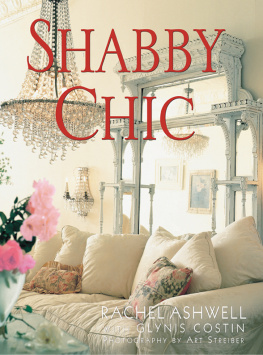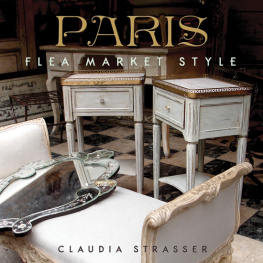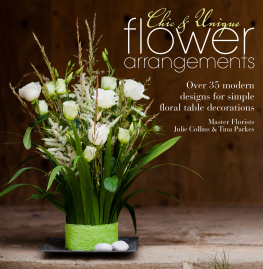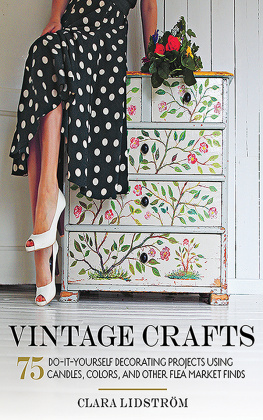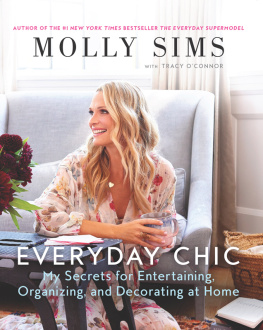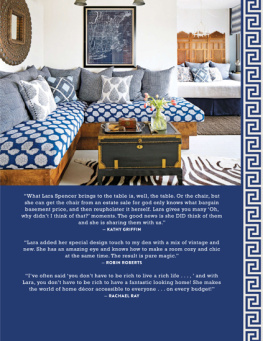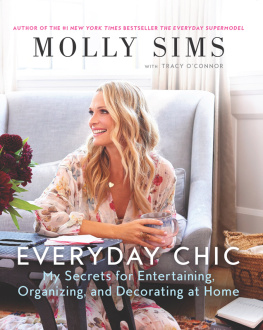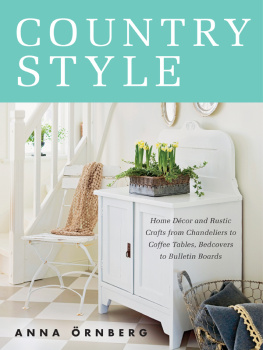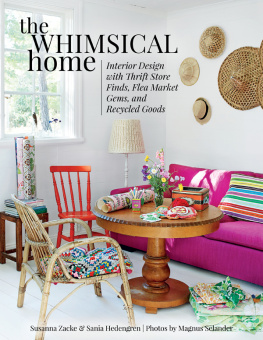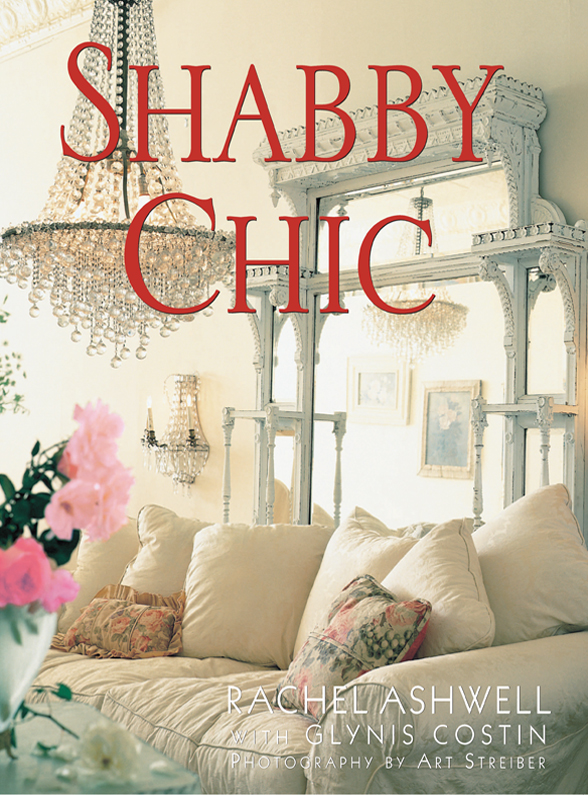
S HABBY
C HIC
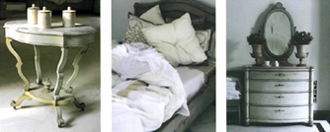
RACHEL ASHWELL
WITH G LYNIS C OSTIN
P HOTOGRAPHY BY A RT S TREIBER

T HIS BOOK IS DEDICATED
TO L ILY AND J AKE .
CONTENTS
S habby Chic evolved as a practical answer to family living. When I found myself a mother of two, in a world of sticky fingerprints and muddy shoe tracks, I began to throw rumpled white denim or cotton over my couches and chairs, as almost more of a whim or afterthought. Slipcovering my furniture wasnt a well-thought-out plan devised to protect my furniture, and it certainly wasnt something I invented. Yet there was a certain appeal to this sensible, washable, portable way of dealing with modern living, and soon my friends began asking for slipcovers for themselves. That is how Shabby Chicthe storebegan.
Since then, Shabby Chic has evolved to include furniture, fabrics, and home accessories that have the same casual appeal and easy style as slipcovers. It is a look that is quiet, simple, peaceful, and practical, allowing for the mixture of many tastes. It does not commit to Victorian, modern, or any other particular era, and can work with a number of different styles or houses. Its a way of life, an outlook, an understanding of what the world already has to offer, and what can be taken, reimagined, and repurposed.
Shabby Chic was born in 1989, and I now have second-generation customers coming to the brandoften people who were raised with it. There are Rachel Ashwell Shabby Chic Couture stores in Los Angeles, New York, and London. The couture stores are my creative playground where I dream and take risks. There are also licensed Shabby Chic products sold in a variety of stores, and there is a Simply Shabby Chic line sold exclusively through Target.
Over the years I have learned that the house itself is of less importance than its contents and how those contents reflect the life within. In my travels, many things have passed through my hands, but those few items that I hold on to are those with the character, wrinkles, and imperfections of history and experience. Ive written six books, but the book you hold in your hands is the original Shabby Chic bible. It is my hope that this book offers insight on knowing how to see things, what makes them appealing and useful, and how they fit into the Shabby Chic aesthetic. While the line has changed, its core values remain the same. It remains committed to moving followers with the passion and the soul of the brand and instilling magic in everyday objects.
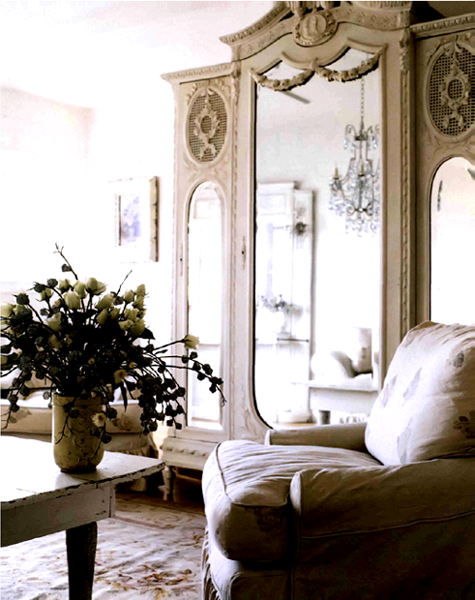

Here is a good example of how flowers, in this case, ones made of painted leather, can be used to adorn common fixtures. Note how the cracks in the wall behind this beveled mirror echo the shabby feeling of the flowers.
C omfort, the beauty of imperfection, the allure of time-worn objects, and the appeal of simple, practical living: These are the cornerstones of what has come to be known as the Shabby Chic style. Shabby Chic, the home furnishings label and retail chain I founded in 1989, is now recognized not only as a brand name, but as a decorating style. Though some may find the phrase shabby chicthe idea that something shabby (faded and dilapidated) can be considered chic (elegant and stylish)paradoxical, the two elements go hand in hand. Shabbiness, in its shunning of what is too new, modern, or ostentatious, as well as in its rebellion against perfection, is precisely what makes this comfortable look so alluring. The COZY familiarity of a well-worn, beloved pair of faded blue jeansversus the starched stiffness of a new pairis the appeal of Shabby Chic.
I didnt invent this relaxed style. Europeans have long appreciated this approach to living: Witness the dilapidated elegance of an Italian villa, French castle, or English country estate whose owners can easily afford new furnishings, but prefer the worn grandeur of faded velvets and peeling vanities handed down from their ancestors. Shabby Chic represents a revived appreciation for what is useful, well loved, and comfortable, for those things that some might perceive as being too tattered and worn to be of use or value.
Collecting important, rare, or costly objects meant to be seen and not touched is not part of the Shabby Chic philosophy. My philosophy of decor is that nothing should be too precious. A child should feel free to put her feet on the sofa, a guest, his cup on the coffee table. I believe in cozy, not fussy; relaxed, not stiff. I believe in living in, on, and around ones things, not merely with them.
A roomy, slipcovered chair big enough for a child and a dog or two, with slightly wrinkled, worn fabric and ample arms perfect for plopping your legs over; an old trunk, its paint peeling around the edges, given new life as a coffee table; a vase of roses from the garden, a bit wilted, a few petals missing; a vintage mirror, framed with a white floral iron piece salvaged from an old gate and chipped in places, but still charming; a slightly rusted flea market chandelier; a scratched-up coal scuttle used as a bread box; an array of vanilla-scented candles adding a warm glow to a cozy roomthese are some of the elements of the effortless, inviting look I prefer. Colors in keeping with this way of living tend to be soft, palatable tones such as seafoam, mint, and celadon greens; dusty roses; pale sky blues; and ivories, creams, and grays that appear to be muted by age, or crisp, clean whites that blend with everything. Brighter or darker colors can occasionally be a part of the look if they are treated with subtlety, combined with white or light colors, or if they appear to be faded by time.
But Shabby Chic goes far beyond the stereotype of a few tea-stained florals and some cushy chairs. Some have called this shabby yet elegant look a marriage between the laid-back, breezy ease of Los Angeles beach life and the romantic prettiness of English country life at its most casual. Others have described it as having the aura of old money, cushy comfort, and crafted indifference or as the merging of a romantic, old-fashioned, aesthetic appeal with modern functions. To these qualities, I would add that the style suggests things that are inherited rather than store bought and handcrafted rather than mass-produced. It is also a style that is appreciative of the beauty of process and evolution.
Im attracted to the quirky appeal of chips, stains, cracks, dents, and irregularities that assert char acier and reveal the charm of history. I gravitate toward the crumbling, the disheveled, the tattered, and the battered. I am drawn to materials that are happily vulnerable to the effects of time, weather, and touch, influences that result in discoloration, staining, tearing, shrinkage, and fading. But I also believe in function, eschewing waste, and in advocating new uses for old forms. In practical terms, this means using washable fabrics, recovering or restuffing an old sofa or chair instead of buying a new one, combining objects that are complementary rather than a perfect match (an approach that is especially handy if you are missing pieces of sets), and paring down as opposed to adding on. I have turned many an old door into a coffee table, crumbling moldings into picture frames, and wicker laundry hampers into end tables. I rarely discard anything that is serviceable and somewhat aesthetically pleasing without at least attempting to find a place and use for it.
Next page
